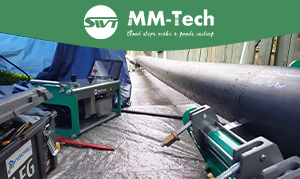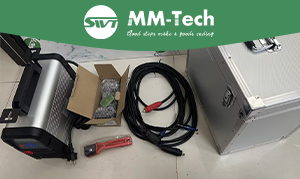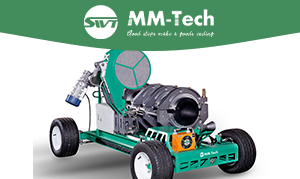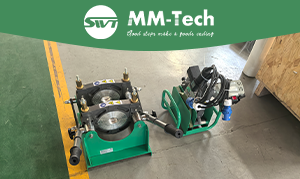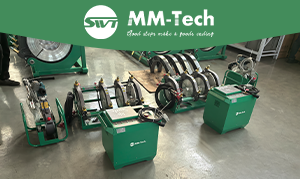To lay HDPE pipe at construction sites, you need special welding tools. These tools are a butt fusion machine, electrofusion welding machine, PPR welding machine, pipe cutters, scrapers, alignment clamps, supports, and safety gear. Using the right welding tools helps make strong and safe pipe joints. The tools also help keep you safe from harm. You can avoid dangers like electric shock, burns, bad fumes, hurt eyes, and sore hands. Laying pipes means you work with heavy HDPE pipes and big machines. Always use the correct tools and wear your safety gear.
Electric shock from welding tools
Burns from hot metals
Breathing in bad fumes during hdpe pipe welding
Eye injuries from welding arcs
Getting hurt by moving pipe sections
Key Takeaways
Use the correct welding tools like butt fusion, electrofusion, and socket fusion machines. These tools help make strong and leak-free HDPE pipe joints.
Get the pipes ready by cutting them straight. Clean the ends with scrapers. This helps make good welds and stops weak joints from forming.
Hold the pipes steady and in line with clamps and supports during welding. This makes the connections last longer and keeps them safe.
Always wear the right safety gear like heat-resistant gloves, eye protection, and strong shoes. This helps stop injuries from happening.
Follow every welding step carefully. This includes getting ready, welding, cooling, and checking the work. Doing this helps build strong and reliable HDPE pipelines.
Essential Welding Tools for HDPE Pipe Laying
When you start laying HDPE pipe, you need the right welding tools. These tools help make every joint strong and safe. Each tool does something special in the process. Using the right equipment helps you follow industry rules. It also helps you avoid problems at construction sites.
Butt Fusion Machine (MM-Tech)
A butt fusion machine is very important for joining HDPE pipes. This machine heats and joins two pipe ends together. The MM-Tech butt fusion machine works fast and is very reliable. It has a strong frame and controls pressure well. This helps you make joints that do not leak and last a long time. The machine is easy to use and has smart features. You can use it for big or small pipe jobs. Digital tools let you check welding settings. This makes your work better and training easier.
Tip: Always make sure your fusion machine is clean and set right before you start. This helps you get strong joints and good results.
Electrofusion Welding Machine (MM-Tech)
You use an electrofusion welding machine in small spaces or for fixing pipes. The MM-Tech electrofusion machine uses smart controls to set the right weld settings. It keeps heat and pressure even for strong joints. The machine is light and simple to use. It works well in the field or in a workshop. You can trust it for repairs or big jobs.
The machine’s smart controls help stop mistakes.
You get a two-year warranty and support, so you can focus on your work.
PPR Welding Machine (MM-Tech)
A PPR welding machine, or socket fusion welder, is best for small pipes. You use it for plumbing and HVAC jobs that need quick, leak-free joints. The MM-Tech PPR welding machine controls temperature well and is easy to carry. It works with HDPE, PPR, and PB pipes. This tool makes jobs faster and safer, especially for small or home projects.
Welder Type | Best Use Cases |
|---|---|
Socket Fusion Welder | Small pipes, plumbing, HVAC, DIY |
Butt Fusion Welder | Large pipes, industrial projects |
Electrofusion Welder | Repairs, tight spaces, high accuracy |
Pipe Cutters and Scrapers
You need pipe cutters and scrapers to get HDPE pipes ready for welding. A pipe cutter lets you cut pipes to the right size with a straight edge. Scrapers clean dirt, grease, and water from pipe ends. Clean, straight cuts are needed for strong joints. Always use sharp, good tools to stop rough edges or dirt. This step helps stop leaks and weak joints.
Alignment Clamps and Supports
Alignment clamps and supports keep pipes steady and lined up when welding. These tools hold pipes in place for a good join. Good alignment is needed for strong, leak-free joints. Clamps hold pipes tight but do not change their shape. Supports help stop pipes from moving and getting out of line. Using these tools is a smart way to lay HDPE pipe safely.
Clamps keep pipes steady and lined up.
Supports stop pipes from moving during welding.
Using them right makes joints strong and last long.
Safety Equipment
Safety equipment keeps you safe when using welding tools for HDPE pipe. You should wear gloves that resist heat, eye protection, and clothes that do not catch fire. Good shoes protect your feet from heavy pipes and hot things. Following safety rules helps you avoid burns, shocks, and other injuries. Good safety habits also help you do better work and keep your team safe.
Note: Always check your safety gear before you start. Replace anything broken to stay safe.
Tool Functions and Applications
Butt Fusion for HDPE Pipeline
You use a butt fusion machine when you need to join two HDPE pipes in a pipeline. The machine heats the ends of the pipes with a special plate until they melt. It then presses the ends together with the right amount of force. This creates a strong, seamless weld that will not leak. The clamps hold the pipes steady, and the control unit keeps the temperature and pressure just right. You can trust this method for any pipeline that needs to last a long time. MM-Tech butt fusion machines help you get reliable results every time.
When you use butt fusion, you make sure the pipeline has joints as strong as the pipe itself.
Electrofusion for HDPE Pipe Joints
Electrofusion welding is a smart way to connect HDPE pipes, especially in tight spaces or for repairs. You use special fittings with metal coils inside. The electrofusion machine sends electricity through the coils, heating the pipe and fitting surfaces. This melts the HDPE and forms a strong weld. The process is clean and reduces the risk of dirt getting into the joint. Electrofusion joints are perfect for pipelines that carry water or gas under high pressure. MM-Tech electrofusion machines give you precise control for every weld.
Socket Fusion for Small Diameter Pipes
Socket fusion works best for small diameter pipes, usually less than 110mm. You heat both the pipe and the fitting, then push them together. This method is simple and does not need much training. You can use it in small spaces, like inside buildings. The welds you make with socket fusion are strong and resist leaks. MM-Tech socket fusion machines help you finish small pipeline jobs quickly and safely.
Cutting and Scraping for Pipe Preparation
Before you weld, you must prepare the HDPE pipes. Use a pipe cutter to make a straight, clean cut. Scrapers remove the top layer and any dirt from the pipe ends. This step is important because it helps the heat reach the right spots during fusion. If you skip this, your weld might not hold. Clean, smooth pipe ends lead to better welds and a safer pipeline.
Alignment and Support in Pipe Laying
Alignment clamps and supports keep your pipes steady during welding. They hold the pipes in the right position so the weld forms correctly. If the pipes move or bend, the weld can fail. Using supports also makes the welding process faster and more accurate. For any pipeline project, these tools help you avoid mistakes and get strong, lasting joints.
HDPE Pipe Welding Process Steps
Preparation and Inspection
You start every hdpe pipe welding process with careful preparation. First, check each pipe for cracks, dirt, or damage. Make sure you have all the welding tools ready, including your MM-Tech butt fusion, electrofusion, or socket fusion machine. Inspect your safety gear and replace anything worn out. Good preparation helps you avoid mistakes and keeps your weld strong.
Cutting and Cleaning
You need to cut the hdpe pipe to the right length. Use a sharp pipe cutter or saw for a straight edge. After cutting, clean the pipe ends. Scrape away dirt, grease, and the top layer of plastic. This step is important for a strong weld. Follow these steps:
Measure and mark the pipe.
Cut the pipe to size.
Use a scraper to clean the ends until you see smooth, fresh plastic.
Wipe away dust and debris.
Clean pipes help the heat reach the right spots during welding.
Alignment and Clamping
Proper alignment and tight clamping are key for a good weld. Use alignment clamps and supports to hold the hdpe pipe steady. If the pipes move or twist, the weld can fail. Make sure the pipes line up perfectly before you start the welding process. Regularly check your clamps for wear and keep them clean.
Tip: Good alignment lets you control temperature and pressure for a high-quality weld.
Welding Cycle (Butt, Electrofusion, Socket)
You choose the welding cycle based on your project. Here is a quick comparison:
Method | How It Works | Best Use |
|---|---|---|
Butt Fusion | Heats both pipe ends, then presses them together for a seamless joint. | Large pipelines |
Electrofusion | Uses electric current in special fittings to melt and fuse pipe surfaces. | Repairs, tight spaces |
Socket Fusion | Heats pipe and fitting, then joins them for small diameter pipes. | Plumbing, small pipes |
Use your MM-Tech machine for each method. Follow the machine’s instructions for heating and joining the pipes.
Cooling and Quality Check
After you finish the weld, keep the pipes clamped while they cool. Cooling under pressure is important for a strong joint. Follow the cooling times in your MM-Tech manual. For bigger pipes, you need more time. Once cool, remove the clamps and check the weld. Look for smooth, even beads and no gaps. Use a thermometer if needed to check the temperature. Good cooling and inspection help your hdpe pipe last longer and stay safe.
Using the right welding tools and following each step helps you build safe and strong HDPE pipelines.
1. Clean pipe ends and use proper tools for strong welds.
2. Control temperature and pressure with advanced machines.
3. Keep pipes aligned and stable for better joints.
MM-Tech machines make your work faster and more reliable. You get strong welds, fewer failures, and support for every pipeline project. Remember to check your tools and follow best practices for every job.
FAQ
What is the most important welding tool for HDPE pipe laying?
The butt fusion machine is the most important tool. You use it to join large HDPE pipes. It creates strong, leak-free joints that last a long time.
How do you keep HDPE pipe joints strong and safe?
You must clean and align the pipes before welding. Always use sharp cutters and scrapers. Check your machine settings. Let the joint cool fully before moving the pipe.
Can you use one welding machine for all pipe sizes?
No, you need different machines for different pipe sizes. Butt fusion works best for large pipes. Socket fusion is for small pipes. Electrofusion fits repairs and tight spaces.
Why is safety equipment important during HDPE pipe welding?
Safety equipment protects you from burns, electric shock, and eye injuries. You should always wear gloves, goggles, and sturdy shoes. Good safety habits help you avoid accidents.


